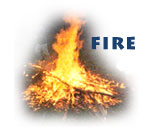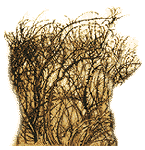|


| While
tending his flocks in the desolate wilderness, Moses arrived at Horeb,
the "mountain of God." Here he suddenly beheld an awesome spectacle
that defied nature's laws and all human experience. A bush was all aflame
yet remained intact, unaffected by the fire. Given its non-material, formless,
mysterious and luminous characteristics, it is understandable that fire
is frequently used in descriptions of the manifestation of the Divine
Presence. [1] |
The Hebrew word
used in this context for bush is seneh. The Hebrew seneh
occurs only here (Exodus 3:2-3 )and in Deuteronomy 33:16, where God
is poetically named "the Presence in the Bush." Seneh
is most likely a deliberate wordplay on Sinai, an intimation of the
Sinaitic revelation foreshadowed in verse 12.[2]
The bush in question has been identified as the thorny desert
plant Rubus sanctus that grows about a yard high near wadis and
in moist soil, and has flowers that resemble small roses and fruit like
the raspberry that turns black when it has ripened. It has also been
identified as the cassia senna shrub known in Arabic as sene.[3]
The startling suspension of nature's fixed laws arouses Moses' curiosity.
"I must turn aside to look at this marvelous sight; why doesn't
the bush burn?" he wonders. At this point the Lord calls out to
him, "Moses! Moses!" In the Bible, repetition of a name often
characterizes a direct divine call.[4]
Similarly, Moses' answer, "Hineini" (Here I am), is
the standard, spontaneous, unhesitating response to a call.[5]
Moses is then told to approach no further and to remove his shoes because
the site is holy ground.[6]
Moses' initial encounter with God is a terrifying experience; "afraid
to look at God," he hides his face -- a reaction is shared by other
biblical characters.[7]
 The
idea of explicitly sacred (Heb. kadosh) space is encountered
here for the first time. No such concept exists in Genesis, which features
only sacred time - the Sabbath.[8]
The pagan mythological notion that certain areas are inherently holy
does not exist in the Bible. It is solely the theophany that temporarily
imparts sanctity to the site, rendering it inaccessible to man. The
idea of explicitly sacred (Heb. kadosh) space is encountered
here for the first time. No such concept exists in Genesis, which features
only sacred time - the Sabbath.[8]
The pagan mythological notion that certain areas are inherently holy
does not exist in the Bible. It is solely the theophany that temporarily
imparts sanctity to the site, rendering it inaccessible to man.
The pictorial detail
of the scene of the Burning Bush has been understood in two different
ways. Most commentators see in fire - an element that is self-sustaining,
requires no substance for its existence or perpetuation, and is wholly
unaffected by its environment - a symbolic representation of the transcendent,
awesome, and unapproachable Divine Presence. The Bible affords ample
justification for this interpretation. In the "Covenant of the
Pieces" in Genesis,[9]
the Lord is said to have come down upon Mount Sinai "in fire."

The imagery is even
more explicit in Exodus: "Now the Presence of the Lord appeared
in the sight of the Israelites as a consuming fire on the top of the
mountain."[10]
In Deuteronomy [11]
the theophany is described as follows: "The mountain was ablaze
with flames to the very skies, dark with densest clouds. The Lord spoke
to you out of the fire; you heard the sounds of words but perceived
no shape; nothing but a voice."[12]
Another line of interpretation sees in the lowly bush a symbol of the
pathetic state of the people of Israel in Egyptian bondage, while the
fire represents the forces of persecution. Just as the bush remains
unconsumed, so Israel will not be crushed by its tormentors and will
survive Egyptian oppression.[13]
This rendering by no means excludes the other, for the biblical
text can simultaneously accommodate multiple levels of meaning.[14]
Overcome with irresistible fascination at the astonishing scene, yet
now profoundly sensible of the divine potency with which the place is
charged, Moses' attention shifts from the visual to the aural. The sight
of the Burning Bush fades away and is not mentioned again. Its place
is taken by the Divine Voice. Here, too, a transformation takes place.
The imperious Voice, commanding and admonishing, gives way to softer
tones of pathos, concern, and tidings of liberation.
|
[1]
Gen. 15:17; Exodus 13:21. 19:18, 24:17; Numbers 9:15-16, 14:14; Deut.
1:33, 4:11-12, 24, 9:3; Ezekiel 1:4, 13, 27, 8:2; Psalms 78:14; Neh. 9:12,
19 [back]
[2] D.N. Friedman, "The Burning
Bush, " Bib 50 (1969); 245-246 [back]
[3] See J. Feliks, The Plant World of
the Bible (Heb.) (Ramat Gan: Massada Press, 1968), pp. 110-112.
M. Zohary, Plants of the Bible (Cambridge: Cambridge University
Press, 1982), p. 140f [back]
[4] Genesis 22:11, 46:2; I Samuel 3:10
[back]
[5] Genesis 22:1,7,11; 27:1; 31:11; 37:13;
46:2; I Sam. 3:4,6,8,16; II Sam. 1:7; Isa. 52:6; 58:9 [back]
[6] In the ancient Near East, removal
of footwear, here probably sandals of papyrus or leather, was a
sign of respect and displayed an attitude of humility. Priests officiated
barefoot; and to this day they remove their footwear before pronouncing
the priestly benediction in the synagogue service. [back]
[7] Gen. 32:31; Judges 6:22; 13:22; I
Kings 19:13; Exodus 20:19; 24:10; 33:20 [back]
[8] Genesis 2:3 [back]
[9] Genesis 15:17 [back]
[10] Exodus 24:17 [back]
[11] Deuteronomy 4:11-12 [back]
[12] Contrast, however, I Kings 19:11-12
[back]
[13] Exodus Rabba 2:10 [back]
[14] The multiple sense of the Scriptures
in emphasized in rabbinic literature. Cf. B. Sanhedrin 34a; B. Shabbat
88b; Numbers Rabba, Naso 13:15 [back] |
|
The JPS Torah Commentary: Exodus (commentary by Nahum Sarna).
Exodus Commentary © 1991, The Jewish Publication
Society.
|
|
 Exploring
Exodus: The Heritage of Biblical Israel
by Nahum Sarna. Schocken Books, 1986. Exploring
Exodus: The Heritage of Biblical Israel
by Nahum Sarna. Schocken Books, 1986.
|
|
|
|
|